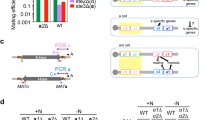Summary
The two idiomorphic alleles calledmat + andmat −, which control the mating types inPodospora anserina, have been cloned.Mat + andmat − encompass 3.8 kb and 4.7 kb respectively, of unrelated DNA sequences flanked by common sequences. Subcloning allowed the identification and localization in each locus of the gene that controls fertilization, probably by determining the mating type. Themat + gene, calledFPR1, encodes a protein with a potential DNA-binding HMG domain. The presence of this motif suggests that theFPR1 polypeptide may act as a transcriptional factor. Themat − gene calledFMR1 encodes a protein containing a motif that is also found in proteins controlling mating functions inSaccharomyces cerevisiae andNeurospora crassa. The role of this motif has not yet been established. Unlike themat + locus, where theFPR1 gene seems to represent the major information, themat − locus contains information necessary for the post-fertilization steps of the sexual cycle besides theFMR1 gene.
Similar content being viewed by others
References
Astell CR, Ahlstrom-Jonasson L, Smith M, Tatchell K, Nasmyth A, Hall BD (1981) The sequence of the DNAs coding for the mating-type loci ofSaccharomyces cerevisiae. Cell 27:15–23
Ballance DJ (1986) Sequences important for gene expression in filamentous fungi. Yeast 2:229–236
Bender A, Sprague GF Jr (1987) MAT αl protein, a yeast transcription activator, binds synergistically with a second protein to a set of cell-type-specific genes. Cell 50:681–691
Boyer WH, Roulland-Dussoix D (1969) A complementation analysis of the restriction and modification of DNA inEscherichia coli. J Mol Biol 41:459–472
Camonis HJ, Cassan M, Rousset J-P (1990) Of mice and yeast: versatile vectors which permit gene expression in both budding yeast and higher eukaryotic cells. Gene 86:263–268
Debuchy R, Brygoo Y (1985) Cloning of opal suppressor tRNA genes of a filamentous fungus reveals two tRNA SerUGA genes with unexpected structural differences. EMBO J 4:3553–3556
Debuchy R, Coppin-Raynal E, Le Coze D, Brygoo Y (1988) Chromosome walking towards a centromere in the filamentous fungusPodospora anserina: cloning of a sequence lethal at a two copy state. Curr Genet 13: 105–111
Egel R, Nielsen O, Weilguny D (1990) Sexual differentiation in fission yeast. Trends Genet 6:369–373
Esser K (1974) In: King RC (ed) Handbook of genetics. Plenum, New York, pp 531–551
Giasson L, Specht CA, Milgrim C, Novotny CP, Ullrich RC (1989) Cloning and comparison of Aα mating-type alleles of the BasidiomyceteSchizophyllum commune. Mol Gen Genet 218:72–77
Glass NL, Vollmer SJ, Staben C, Grotelueschen J, Metzenberg RL, Yanofsky C (1988) DNAs of the two mating-type alleles ofNeurospora crassa are highly dissimilar. Science 241:570–573
Glass NL, Grotelueschen J, Metzenberg RL (1990a)Neurospora crassa A mating-type region. Proc Natl Acad Sci USA 87:4912–4916
Glass NL, Metzenberg RL, Raju NB (1990b) Homothallic Sordariaceae from nature: the absence of strains containing only thea mating type sequence. Exp Mycol 14:274–289
Gubbay J, Collignon J, Koopman P, Capel B, Economou A, Muensterberg, A, Vivian N, Goodfellow P, Lowell-Badge R (1990) A gene mapping to the sex-determining region of the mouse Y chromosome is a member of a novel family of embryonically expressed genes. Nature 346:245–250
Henikoff S (1984) Unidirectional digestion with exonuclease III creates targeted breakpoints for DNA sequencing. Gene 28:351–359
Herskowitz I (1989) A regulatory hierarchy for cell specialization in yeast. Nature 342:749–757
Jantzen H-M, Admon A, Bell SP, Tjian R (1990) Nucleolar transcription factor hUBF contains a DNA-binding motif with homology to HMG proteins. Nature 234:830–836
Kelly M, Burke J, Smith M, Klar A, Beach D (1988) Four matingtype genes control sexual differentiation in the fission yeast. EMBO J 7:1537–1547
Mahler HR, Cordes EH (1966) Biological chemistry. Harper and Row, New York, pp 10–13
Metzenberg RL, Glass LN (1990) Mating type and mating strategies inNeurospora. BioEssays 12: 53–59
Mutasa ES, Tymon AM, Göttgens B, Mellon FM, Little PRF, Casselton LA (1990) Molecular organization of an A mating type factor of the basidiomycete fungusCoprinus cinereus. Curr Genet 18:223–229
Pearson WR, Lipman DJ (1988) Improved tools for biological sequence comparison. Proc Natl Acad Sci USA 85:2444–2448
Picard M, Debuchy R, Coppin E (1991) Cloning the mating types of the heterothallic fungusPodospora anserina: developmental features of haploid transformants carrying both mating types. Genetics 128:539–547
Rizet G (1940) Sur les diverses formes de la distribution des ‘sexes’ chez lePodospora minuta. CR Soc Biol 133:31–32
Sanger F, Nicklen S, Coulson AR (1977) DNA sequencing with chain-terminating inhibitors. Proc Natl Acad Sci USA 74:5463–5467
Sinclair AH, Berta P, Palmer MS, Hawkins JR, Griffiths BL, Matthijs JS, Foster JW, Frischauf A-M, Lovell-Badge R, Goodfellow PN (1990) A gene from the human sex-determining region encodes a protein with homology to a conserved DNAbinding motif. Nature 34:240–244
Staben C, Yanofsky C (1990)Neurospora crassa a mating type region. Proc Natl Acad Sci USA 87:4917–4921
Tabor S, Richardson CC (1987) DNA sequence analysis with a modified bacteriophage T7 DNA polymerase. Proc Natl Acad Sci USA 84:4767–4771
Tatchell K, Nasmyth KA, Hall BD, Astell C, Smith M (1981) In vitro mutation analysis of the mating-type locus in yeast. Cell 27:25–35
Tsuda KI, Kikuchi M, Mori K, Waga S, Yoshida M (1988) Primary structure of non-histone protein HMG1 revealed by the nucleotide sequence. Biochemistry 27:6159–6163
Turcq B (1989) Clonage direct de gènes par complémentation chez le champignonPodospora anserina: application à létude de gènes d'incompatibilité. Thèse no. 62, Université de Bordeaux II
Yanisch-Perron C, Vieira J, Messing J (1985) Improved M13 phage cloning vectors and host strains: nucleotide sequences of the M13 mp18 and pUC19 vectors. Gene 33:103–109
Author information
Authors and Affiliations
Additional information
Communicated by W. Gajewski
Rights and permissions
About this article
Cite this article
Debuchy, R., Coppin, E. The mating types ofPodospora anserina : functional analysis and sequence of the fertilization domains. Molec. Gen. Genet. 233, 113–121 (1992). https://doi.org/10.1007/BF00587568
Received:
Issue Date:
DOI: https://doi.org/10.1007/BF00587568




